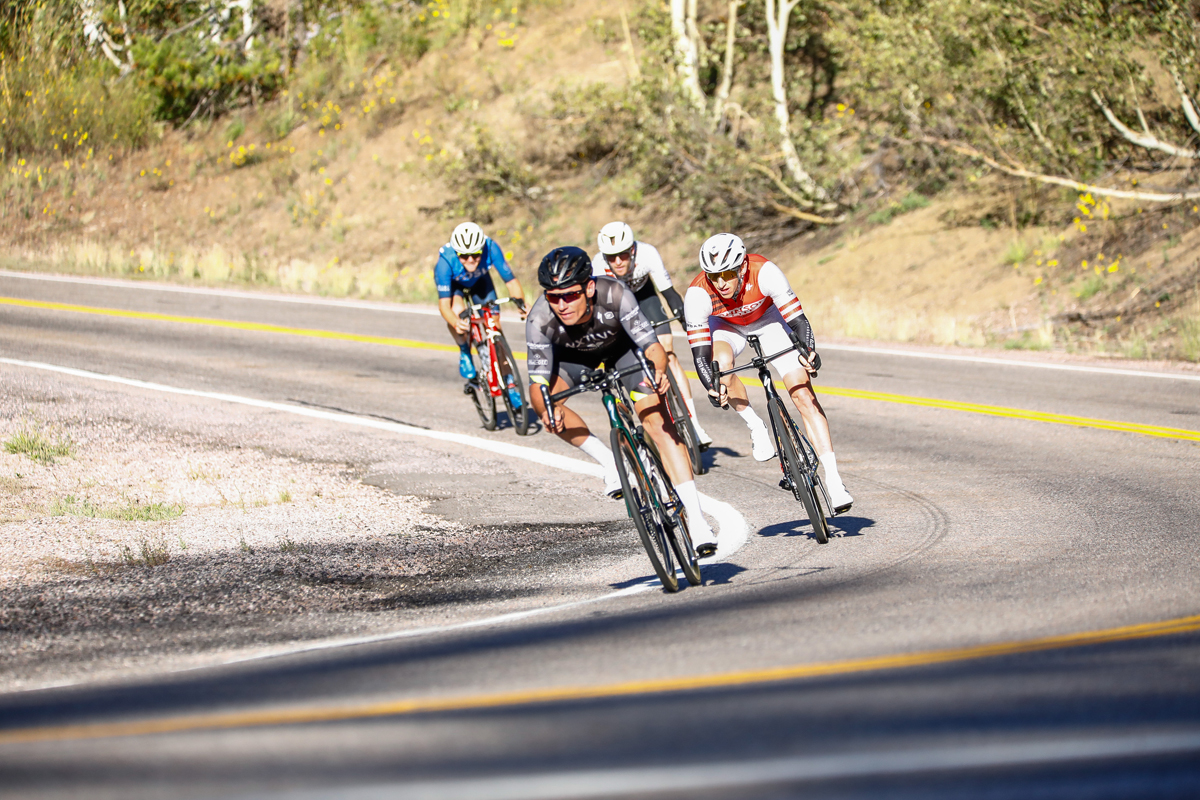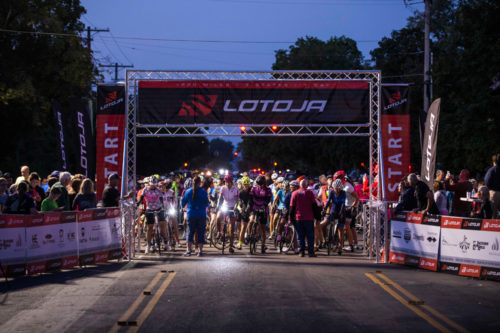
By David Bern
With a strong tailwind, old course records tumble
A former U.S. men’s continental pro team rider, and a relative newcomer to women’s racing, won their respective Pro 1-2-3 categories in the 35th annual LoToJa Classic on Sept. 9.
Kai Applequist (Team Mercedes Benz – Thrivent Financial), 34, of Boise, Idaho, beat Kyle Van Renterghem (Team Stone House Group – Monster Media Racing) to the line after a long sprint and set a new men’s record of 8:42:31 for LoToJa’s 202-mile parcours.
He broke the previous record of 8:45:38 set by Cameron Hoffman in 2014. But Applequist downplayed the achievement and indicated it wasn’t his or his teammates’ race-day objective.
“We didn’t ever think about the record,” he said. “Everyone played a part and did a lot of work for the team. … We came to race and win, not to survive.”
In another furious sprint, Lindsey Stevenson (Team Endurance), 28, of Salt Lake City, crossed the finish in 9:35:15.6 with Christie Tracy (Team ATC Racing) closing fast. Stevenson just missed setting a new LoToJa women’s record by 16 seconds.
“It felt so good,” Stevenson said about winning. “… Afterward I was just walking around thinking, ‘Oh my, gosh. I just won LoToJa!”
Both Applequist and Stevenson were joined by nearly 1,500 other licensed and cyclosportive riders who rolled away from Sunrise Cyclery in Logan, Utah, early that morning and headed north toward the finish at Jackson Hole Mountain Resort.
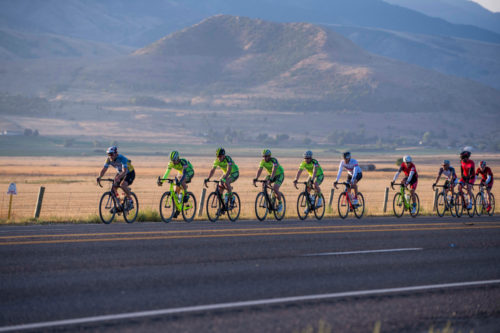
LoToJa is billed as the longest one-day USA Cycling-sanctioned bicycle race in the U.S., with three mountain passes, and nearly 10,000 vertical feet of climbing. Licensed cyclists ride 202 miles (325km) and cyclosportive riders 205 (330km) while passing through northern Utah, southeastern Idaho and western Wyoming.
Men’s Recap
Applequist, who is the director of Team Mercedes and rode for U.S. Pro Team Xergy with Fred “Fast Freddy” Rodriguez from 2011-12, said before the start, he and his teammates of Jeremy Ward, Josh Howard and Todd Meier discussed the day’s tactics. They were simple: Get a man into an early break and be competitive during the final 60 miles of the race.
That early break happened shortly after the peloton of 26 Pro 1-2-3s and 22 Master 35s left Logan in the dark at 6:07 a.m. As per plan, Meier was in the break with Montana’s Coul Hill (unattached). The two men quickly got a gap that grew to five minutes when the peloton crossed the Bear River after Preston and started the 22-mile climb to Strawberry/Emigration Canyon’s 7,424 foot-high summit (57mi/92km).
Applequist said both Hill and Meier were caught before the summit and the bunch rolled single file over the top. The ride up the canyon wasn’t decisive, he said, nor was the descent to Ovid and the flat, seven-mile leg to the first support crew feed zone at Montpelier (76mi/122km). In Montpelier, Meier dropped out due to illness.
After the feed zone, two unidentified riders attacked, said Applequist, during the nine-mile climb to 6,923 foot-high Geneva Summit (84mi/135km). But because the peloton wasn’t motivated to chase, the pair had a one-minute gap by the top. It stayed that way down the backside of Geneva, and to the Idaho/Wyoming stateline.
But at the base of Salt River Pass, things started to get animated, Applequist said. Five to six riders started to “drill it,” he said, including himself, teammates Ward and Howard, and former winner Chris Carr (Denver Fit Loft Pinarello), to name a few. Carr, noted for his climbing, went to the front and pushed the pace to LoToJa’s highest summit: 7,630 foot-high Salt River Pass (106mi/171km), which features a 9-percent pitch during the last two miles.
During the climb, the two-man break was caught by the bunch and the group now was seven on the descent into Star Valley. Soon, others who were dropped on the climb to Salt River Pass bridged. Applequist noted that his team’s support crew didn’t make it in time from Montpelier to Afton — so his team rolled through the feed zone at Afton (123mi/198km) without taking food or water.
“We didn’t get food until Alpine Junction,” he said. “We had to tough it out.” Also, Howard flatted just before Afton. Without team support nearby, it was thought he was out of the race, said Applequist.
About 10 miles after Afton, he said either Kevin Nicol or Benjamin Blaugrund, both of Team JUWI, attacked and pushed toward Alpine Junction (156mi/251km).
“He got 45 seconds quickly,” Applequist said. “No one was willing to work. I told Jeremy [Ward] we were working for him.” With that, Applequist went to the front and started to work. But it wasn’t until around Hoback Junction (178mi/286km) that the one-man break was caught.
“We caught him and attacks started right away,” he said. “I went out the back a couple of times.”
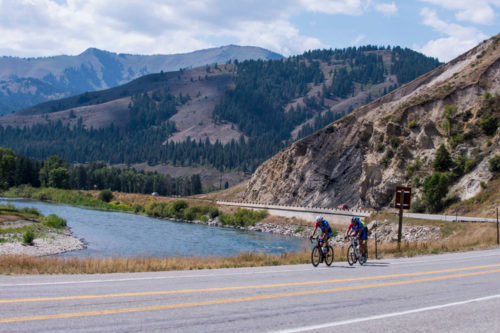
But Applequist never lost contact. The group stayed together from Hoback to the left turn onto South Loop Road. But attacks, one of which came from Carr, began in earnest once the bunch hit the bicycle path before Wilson and the final seven-mile leg on Village Road to the finish.
“I was on the rivet,” said Applequist. “ I was hanging on for dear life on the bike path.” He added that Carr, not being a sprinter, had to try to get away, to make it his race before the finish. But he was caught and together the bunch crossed the pedestrian foot and bicycle bridge over the Snake River, and turned onto Village Road.
Applequist said he tried to even out the workload so Ward would have enough energy to win the sprint. But then he began to suffer.
“All my muscles cramped at that point,” he said. “I thought I was done. But I got back to the guys.” After that, the cramps stopped and he went to the front for Ward.
With 4-5 km left to the line, Applequist and Van Renterghem found themselves with a 5-10 second gap. Then it opened even more. Applequist said he didn’t have much left and Van Renterghem was motoring.
“I did what I could,” Applequist said. “He [Van Renterghem] drove it to the last 300 to 400 meters. His hope was I had nothing left and my hope was I had something left.”
At 300 meters, Applequist drew around Van Renterghem and sprinted with everything he had — and crossed the line alone. Van Renterghem finished one second back.
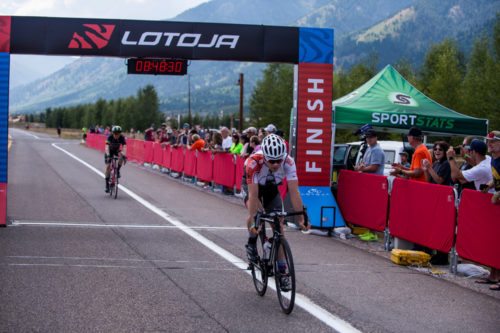
Taking third was two-time winner Ira Sorensen (Team Canyon Cycles) at 8:42:45.2, fourth place was Nicol at 8:42:45.2, fifth was Ward at 8:42:45.3, sixth was Derek Edwards (Team Zanconato) at 8:42:45.4, seventh was Spencer Johnson (Team Spider Boot) at 8:42:45.8, eighth was Blaugrund at 8:42:48, and ninth was another past LoToJa winner, Carr at 8:42:49.3.
Applequist, who rode for “Fast Freddy” on Team Exergy and raced the Philadelphia International Cycling Classic, the Tour of Utah, the Tour of Bulgaria and many other pro races, said he wasn’t surprised taking the win.
“If you truly race as a team, opportunities present themselves,” he said. “… I honestly don’t care if I win. What means more to me is that the team rides well … and with panache.”
Applequist said he isn’t sure if he’ll defend his LoToJa title in 2018.
Women’s Recap
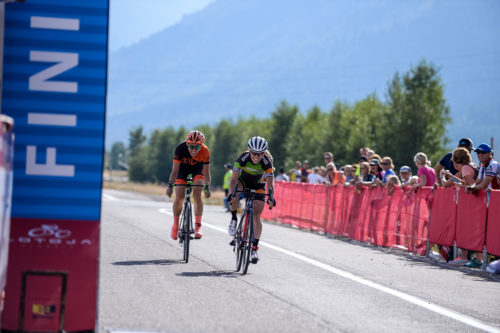
Photo by Lucid Images, find photos at lucidraces.com/2017-lotoja-classic
But this year’s Pro 1-2-3 women’s winner doesn’t have any doubts about her future LoToJa plans.
“I’d love to win it again,” Stevenson said. “I want to come back even stronger and to win.”
2017 was Stevenson’s first year at full-time racing. Even though she had marked some big finishes throughout the year, and felt confident rolling up to the start line in Logan, she fought back some doubt.
“I knew I was strong, but then I looked at the fitness of the other women, and they looked fierce!” Stevenson said. One of her biggest concerns was her friend and rival Marci Kimball (TOSH), who won LoToJa last year and is a renowned climber.
The women’s field that left Logan at 7:10 a.m. contained 7 Pro 1-2-3s, 29 4-5s, 18 35-plus masters and 11 45-plus masters. Stevenson said the peloton stayed together through Cache Valley. As the women began the 22-mile climb to Strawberry/Emigration Canyon’s summit, Stevenson said she stayed 10 wheels back from the front through the rollers. And waited.
“I knew Marci was going to attack on Strawberry,” she said.
Which is exactly what happened after the road began to pitch upward. Kimball attacked, Stevenson responded, and so did three other riders, including Christie Tracy (Team ATC Racing).
“Marci stayed at the front,” said Stevenson. “No one could pull through … Marci rode so easily.”
After a few miles, Kimball and Stevenson were alone, crossed the summit and began the descent to Ovid. Several minutes later, Tracy bridged up to them.
“She must have killed herself to reach us,” Stevenson said.
The threesome decided not to wait for other riders to join them and help with the work. Stevenson said Kimball urged that they go for breaking the women’s record.
After the feed zone at Montpelier, the trio headed for Geneva Summit and crossed it together. They descended Geneva and headed for the Idaho/Wyoming state line. But moments later, Kimball’s race came to an end.
“I did not see what happened, but I heard it,” Stevenson said.
Tracy was at the front, followed by Stevenson and Kimball. On a section of freshly laid chip seal and tar, Kimball’s front wheel evidently struck a rock or object, momentarily lost control, and slammed to the ground.
Tracy and Stevenson turned around and were stunned to see Kimball sprawled on the road and then quickly surrounded by responding motor marshals.
“We both began to soft pedal for Marci,” said Stevenson. “She’s tough and we thought she’d get right back up. All I could think of was that’s my friend. We were barely moving.”
A motor marshal drove up to Tracy and Stevenson and gave them the bad news. Kimball had been knocked out and was seriously injured. She wouldn’t be getting back on her bike.
“I was rattled,” said Stevenson. “Should I stop and go back, but I can’t do anything. I was pissed. I felt guilty. Marci never crashes. But I had to get it together. I had to focus and get back into the race.”
Stevenson said she and Tracy rode in silence past the state line and to the base of Salt River Pass. There, Tracy told Stevenson to go for the QOM.
On the descent into Star Valley, Stevenson ate and drank while waiting for Tracy to catch up.
Stevenson said she and Tracy rode the “drudgery” of Star Valley well together. They maintained a strong pace through Afton and Alpine Junction, and continued the effort toward Hoback Junction. There, Stevenson nearly crashed while grabbing a bottle from a volunteer.
“That was real scary,” she said. “If I had crashed there, I would have been devastated.”
Stevenson said on the last climb before the left turn onto South Loop Road, she decided not to try to drop Tracy and instead have their race end in a sprint. The two continued to take pulls along South Loop Road, on the bike path and Village Road.
“With 5K to go, I’m thinking I have a shot,” said Stevenson. “I was feeling as good as you can at the end of LoToJa.”
At 1K to go, Tracy was at the front and Stevenson heard her shift. The sprint was on.
“I grabbed her wheel and then I went around her as wide as I could,” Stevenson said. “I could feel and see her just behind me. She closed in, but not in time.”
Tracy crossed the line behind Stevenson with a time of 9:35:15.8. Ingrid Smallman (Team Endurance) took third with a time of 9:54:58, followed by Betsy Cordes (Bozeman Masters Velo) 10:18:54.5, and Allison Atkinson (Wattage Cottage) 10:42:33.
LoToJa Race Director Brent Chambers said the 35th anniversary event was successful and memorable — and his pre-race prediction that some course records may tumble came true. A strong tailwind throughout the day eased some of the burden for riders, and perhaps played a role in Applequist setting a new record, and Stevenson only being seconds away from setting one, too.
Chambers congratulated all riders and support crews who participated this year, and urged everyone to recognize that LoToJa wouldn’t be possible without the event’s 700 volunteers and the cooperation of communities and residents along the course.
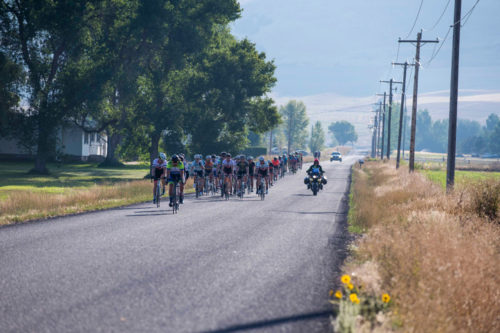
2017 LoToJa facts and Trivia
• The first LoToJa was held in 1983 and was won by Bob Van Slyke of Logan, Utah, with a time of 9 hours. Six other cyclists started and finished on that day.
• Men’s individual course record (new): Kai Applequist, Boise, Idaho – 8:42:31
• Women’s individual course record: Melinda MacFarlane, Draper, Utah – 9:35:00 (2013).
• Tandem course record: Gary Gardiner & John Lauck, Centerville, Utah -9:05:57 (2014).
• Race relay course record (new): 2-person team – Dwight Perkins & Daniel Price, Twin Falls, Idaho – 8:54:30. Previous record was 8:54:37 (2013).
• Race relay course record: 3-5 person team – Martin Acostra, James Crawford, Casey Nielsen, Trent Olsen and Nathan Starnes, Ogden, Utah – 8:54:30 (2013)
• King of the Mountain record (new): D. Justin Daniels, Cedar City, Utah – 12:21:814. Previous record was 12:41:001 (2013).
• Queen of the Mountain record: Shirley Leydsman, Ivins, Utah – 16:19:212 (2014).
• Since 1983 more than 18,000 cyclists have pedaled more than 4 million combined miles during LoToJa.
• Oldest individual finishers: Male – Michael Washburn, 75, and his wife Leesa Washburn, 64.
• Oldest individual category winners: Male – Larry Peterson, 72, Centerville, Utah; Female – Celeste Lilenquist, 56, Bountiful, Utah.
• Youngest individual finishers: Male 13 and Female 13.
• LoToJa’s average participant age is 43.
• In a typical year, LoToJa cyclists travel to Logan from 40 U.S. states and six foreign countries.
• LoToJa requires over 600 course volunteers. One hundred and fifty are Ham radio operators who provide communications and neutral support.
• LoToJa has raised almost $2 million for the Huntsman Cancer Foundation
• In addition to helping Huntsman, LoToJa has raised several thousand dollars for ASD Connections, the National Ability Center, Common Ground Outdoor Adventures, Utah High School Cycling League, Bike Utah, as well as several community organizations and youth groups.








